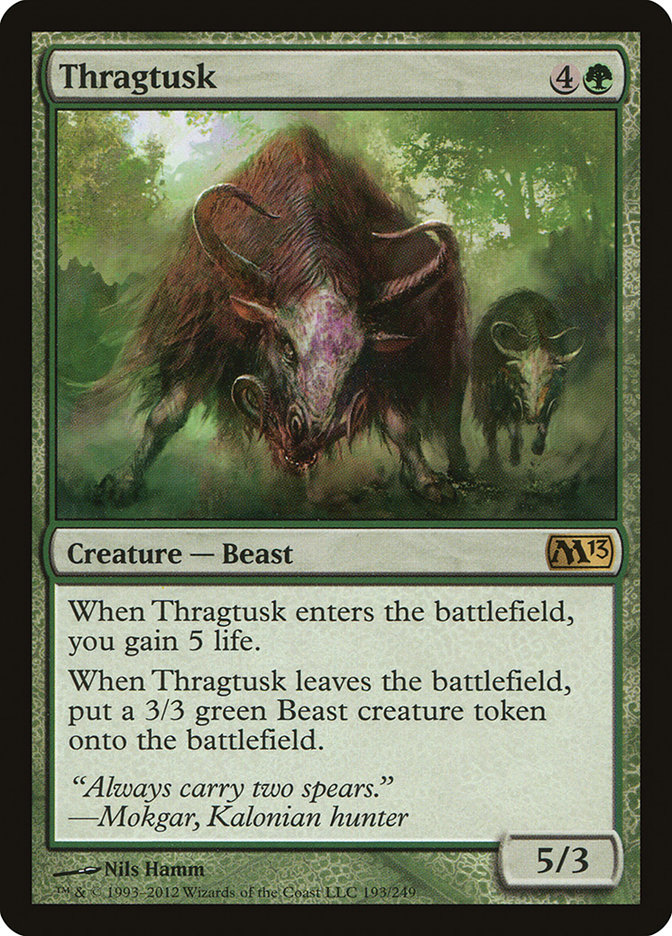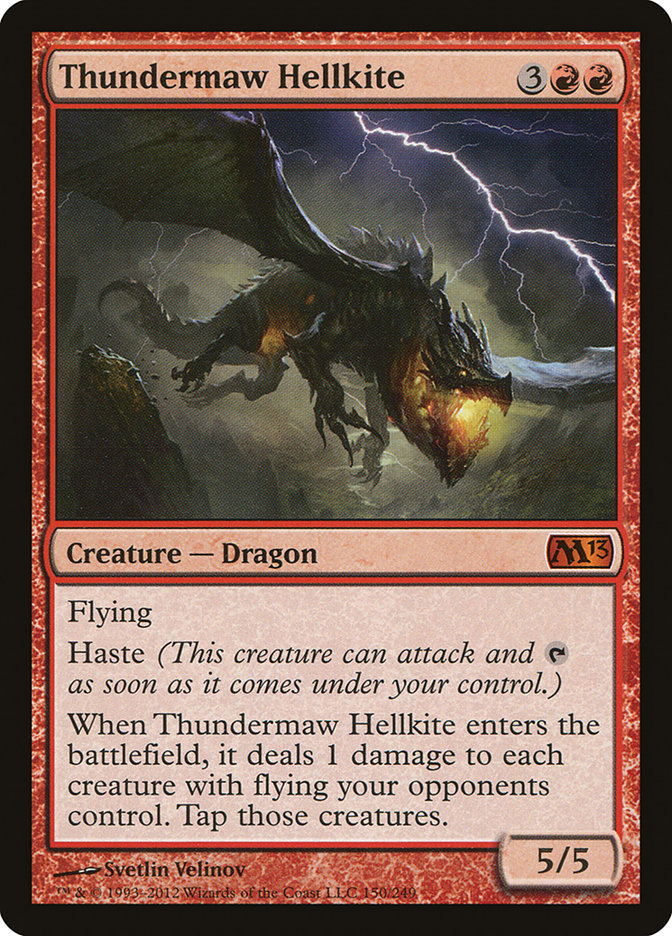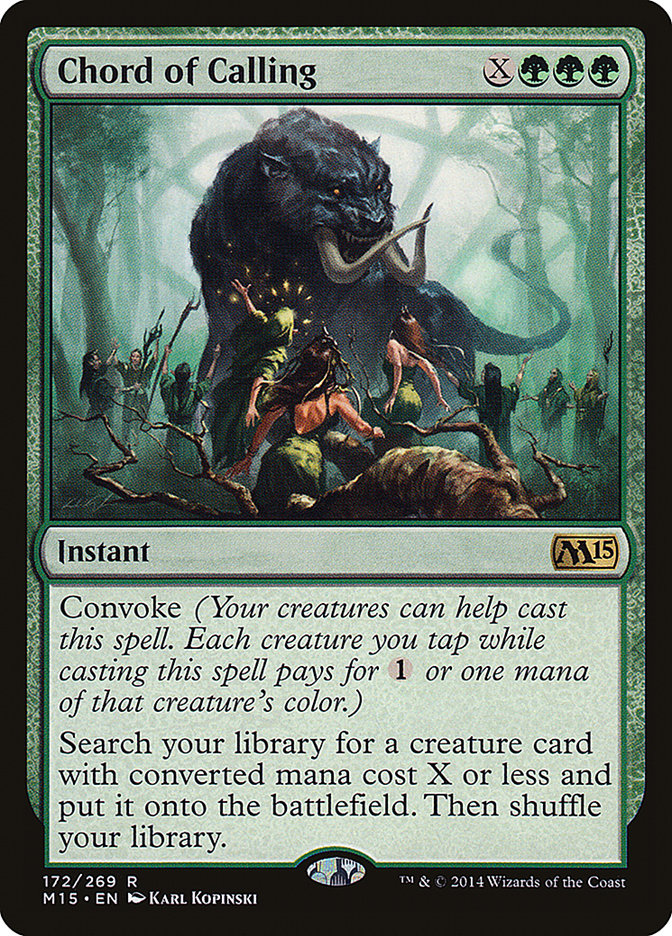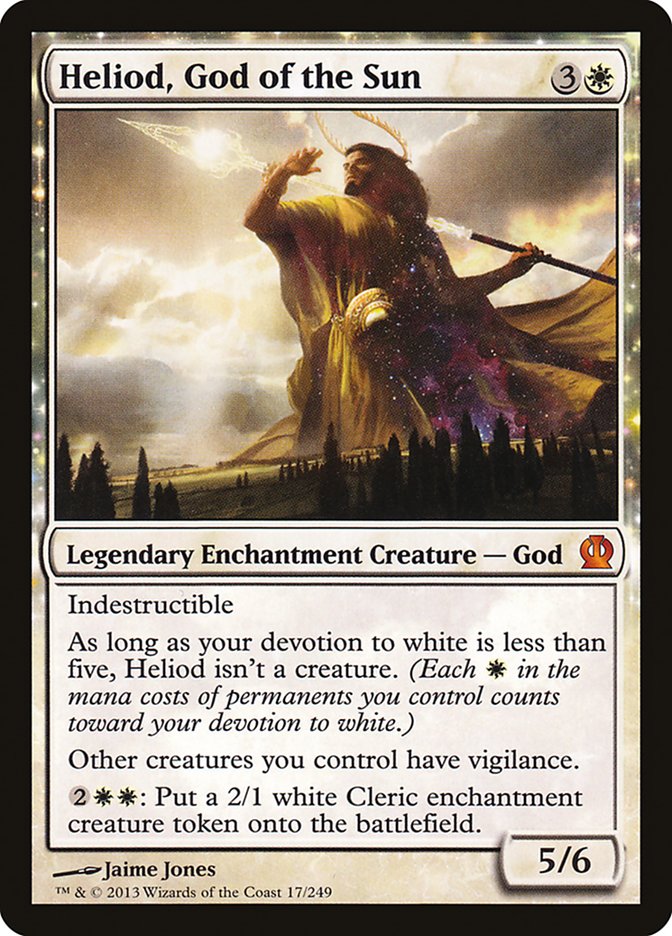The new Standard format is almost here, and I can’t wait to get my hands on Fate Reforged. There are quite a few powerful cards for us to tinker with, but
I think there are many Standard contenders hiding under the radar. While I’m not sure what the best home for those cards will be just yet, I figured today
was as good as any to get to work on building new decks.
I think one major problem with the new set is that it does seem a bit…overly complicated. I don’t mean that in a bad way, but mostly I just mean that
many of the cards we’re used to seeing these days are pretty straightforward.
These are the types of threats we’re used to. Big monsters that hit hard or have some ability to make up for what we spent on playing them. Even if they
died somehow, they either did a lot of damage or gained a bit of value. But no, Fate Reforged looks and feels different. There are more strange
interactions, and in those strange interactions comes complication. And with complication comes an inability to properly deduce how good or bad a card can
be.
Everyone knew that the cards listed above would be good at some point in their Standard lifetime. But what about Tasigur, the Golden Fang? What about
Frontier Siege? Hell, even Valorous Stance looks pretty tame upon first viewing. If I hadn’t seen it in action already, I would think it was just a very
good card in Limited.
Many of the cards in Fate Reforged come with a choice. In the past, modal spells were something of a luxury. Esper Charm and its cycle, and moving into
Izzet Charm and their cycle from Return to Ravnica, many of those cards saw a lot of play in Standard, let alone Modern or Legacy. So it is safe to say
that nearly any modal spell we come across probably deserves a second look. At the very least, having a split card is pretty awesome, so long as one part
is always useful, while the other parts have their time and place.
I’m not saying that there will be a hundred cards in Fate Reforged that end up seeing play in Standard, but what I do think is that there are a lot of
cards hidden in the rough, waiting to see the light of day. When Fate Reforged is released this weekend, we will only get a taste of what is to come. I
could be wrong, but I’m already seeing some powerful interactions in the hands of a few cards I didn’t expect would be playable at all.
Siege Engine
At first glance, I thought nothing of a four-mana spell that gained you two extra mana each turn. In a lot of ways, that’s what Market Festival does,
except you can add additional colors to the mix. After playing with Frontier Siege just a few times, I learned that it is extraordinarily powerful when you
are trying to abuse its ability to create four mana per turn.
So the game now becomes “How do you spend four extra mana each turn?” There are a few answers to that question in Standard, but the long and short of it is
that you need to have a permanent with an activated ability, or you need to be drawing a lot of cards. Do you notice how delicately Frontier Siege works
with Divination? Read the Bones? Even making some delve cards cost less mana allows you to play more of them. Perhaps it is possible to make a deck that
plays both Treasure Cruise and Dig Through Time without worrying about whether or not you’re going to run out of fuel!
But my main objective for the next day or two is figuring out if you can build a reliable engine around Frontier Siege and Eidolon of Blossoms. Banishing
Light, much like Divination or Read the Bones, allows you to put that extra mana to good use while also giving you a way to interact with planeswalkers,
large creatures, or even Whip of Erebos. But there’s also a lot of value to Frontier Siege just by using it as another ramp spell. Imagine how easy it
might be to cast Hornet Queen or even Ugin, the Spirit Dragon two turns ahead of schedule!
It just reeks of unlocking a busted Mono-Green Devotion deck.
But the major problem with any mana accelerant is that you need something to do with that mana all the time instead of just one big spout. Relying on too
much fat in your deck will leave you with hands that are incredibly vulnerable to sweeper effects and counterspells, making U/x Control your number one
threat. And with the addition of Crux of Fate to U/B Control’s arsenal to go along with End Hostilities from U/W, it might be too much for a Green Devotion
deck to handle.
So we want consistency, a way to use the extra mana every turn, and some big top-end spells to give us a reason for ramping. What is one spell in Standard
that could give us all three?
One thing Chord of Calling does is allow you to use extra mana. When you can grab any and every creature the format has to offer, Chord of Calling can be
quite ridiculous. On top of being one of the cards that you would want to draw the most, it allows you to effectively play more top-end spells without
being too clunky. It also gives you more virtual copies of Eidolon of Blossoms, which is fantastic.
Chord of Calling also makes it more appealing to play additional colors. Here is a short list of reasonably costed creatures that I might want to splash
that go rather well with what we’re trying to do.
The last card on the list, Purphoros, is more of a combo-kill card with Hornet Queen than anything, but you can still put the extra mana to good use by
pumping all of your mana accelerants. Having access to it as a one-of could also make your control matchups better, giving you a way to turn any creature
into a threat when the game is going long.
The other two are more applicable to what we’re trying to do already. Tasigur can help refuel after getting hit with a few removal spells, while also
giving you a reason to play Satyr Wayfinder and possibly Murderous Cut. The fact that Doomwake Giant pairs very well with Eidolon of Blossoms makes the
black splash seem much stronger than any of the other options, but I’m not quite sold just yet. There is a lot to be said about playing Banishing Light,
Heliod, and a few other good white cards to go alongside the Eidolon. But with Monastery Mentor potentially posing a huge threat, this might be the perfect
time for a Doomwake Giant comeback in the Green Devotion decks.
That isn’t to say that these decks need to be devotion-based. Nykthos is fairly unreliable at times, though you can’t argue with its explosive nature
against other midrange strategies. Nykthos is the reason to play the deck and makes so many other cards in the deck significantly better. But perhaps we
don’t need to go overboard, as drawing multiple copies of Nykthos can lead to some anemic draws. And if you want to play Tasigur or Murderous Cut, then
that gives you an additional reason to play Satyr Wayfinder.
Creatures (27)
- 2 Hornet Queen
- 4 Elvish Mystic
- 1 Polukranos, World Eater
- 4 Sylvan Caryatid
- 4 Courser of Kruphix
- 2 Satyr Wayfinder
- 4 Eidolon of Blossoms
- 2 Doomwake Giant
- 1 Pharika, God of Affliction
- 1 Reclamation Sage
- 1 Whisperwood Elemental
- 1 Tasigur, the Golden Fang
Lands (24)
Spells (9)

It is not a certainty that Chord of Calling is a better card for this deck than Genesis Hydra. In fact, a version sticking closer to the original featuring
the full four copies of Polukranos but utilizing Frontier Siege to power out bigger and bigger copies of Genesis Hydra might be the place we end up. But
that’s boring. It’s been done before, and you don’t want or need another article on how ridiculous Nykthos can be. After all, we’re trying to spotlight new
cards here.
Genesis Hydra does have its upsides, but Chord of Calling is a bit more…precise. It allows you to play a game of “find the bullet” in matchups where you
desperately need to draw a certain kind of card. Against Whip of Erebos, we have Reclamation Sage. Against control decks, we have Whisperwood Elemental.
There are also plenty of occasions where getting a Polukranos can let you sweep away the opponent’s board while creating a literal monster. What Chord of
Calling lacks in strength, it more than makes up for it in consistency, which is exactly the type of card you want alongside Frontier Siege.
One of the most degenerate things you can do with Chord of Calling is to find your first copy of Eidolon of Blossoms. While we don’t have an extraordinary
number of enchantments in the deck, having Chord of Calling act as an effective enchantment is quite powerful. And when it becomes the second copy of
Eidolon of Blossoms, things can get a little out of control. The same can be said for Doomwake Giant in a matchup where its ability is particularly potent.
But Chord of Calling is a bit slow at times and doesn’t always help you get to where you need to go. If you’re playing against a deck with a significant
number of cheap removal spells or sweeper effects, Chord of Calling can be rather expensive and bland. However, the times where you find exactly the right
card at exactly the right time can be priceless. Can you imagine finding a Phyrexian Revoker in response to an Ugin, the Spirit Dragon? What about a
Whisperwood Elemental in response to End Hostilities? While this usually requires a certain bit of luck, there are enough times that just getting a mana
accelerant or Eidolon of Blossoms is good enough.
This is not a traditional Devotion deck. We aren’t going crazy with Nykthos, as you can see from the lack of Voyaging Satyr. Instead we’re using a sharp
knife instead of the usual cudgel. We have a much different gameplan, though that gameplan will still involve access to a lot of mana and hopefully some
powerful things to do with it.
As of this moment, I’m not sure if the core for this deck is exactly correct. Polukranos has always been a fine, upstanding gentleman, and I don’t exactly
like the prospect of cutting back on them. Polukranos is a great sink for excess mana, which this deck will generally have a lot of. But we’re just trying
something new, and I figured that the four-drop slot didn’t need to stay so cluttered. I will just say that it is difficult to make room for all the cards
you want in your deck when you have access to Chord of Calling. The trick to making the deck work is having most of the creatures you would normally search
for be pretty decent on their own. Polukranos was great at this, but playing four prevents you from having a bit of diversity in the threats you can
present to your opponent.
I’m not completely sold on Tasigur, the Golden Fang without access to more ways to fuel delve, but I can only assume that his ability is bonkers with
Frontier Siege. With that said, this deck has a bit more air in it than most, and you will be often rewarded for your efforts with more mana accelerants,
but the times where you get to rebuy Murderous Cut or Chord of Calling is just great. His ability does get worse as the game goes on, but I would assume
that he’s done his job if you’ve activated his ability more than a single time.
As we talked about before, the matchup against U/x Control is quite atrocious in the maindeck. But for that exact reason, we are flooding the sideboard
with cards that are great against them, yet are powerful in other matchups to boot. Nissa, Worldwaker is an auto-include, giving you a way to interact
proactively against any sort of control deck. The fact that the 4/4 elementals she creates die to neither Ugin or Perilous Vault is a huge plus. The
downside is that now Crux of Fate is a thing, and we have to be very careful not to overextend onto the board.
The combination of Thoughtseize and Brain Maggot is pretty cute, but I’m not sure it is actually good. You want to cut Sylvan Caryatid against control
decks, meaning you’ll have fewer black sources to actually cast these spells. However, you don’t need to cast them early. A Thoughtseize on turn 4 or 5
could open a window to land a particularly powerful effect, taking away their counterspell or removal spell in the process. Similarly, you can use Chord of
Calling to find Brain Maggot to do the dirty work for you, drawing you a card in the process if you so happen to have an Eidolon of Blossoms in play.
The rest of the sideboard is a smattering of tutor targets and moving up to the full four copies of Reclamation Sage, which we will probably want against a
Whip of Erebos deck. That will be their main attempt to stay at parity with you, but just killing a Courser of Kruphix early in a game can be invaluable.
After all, that’s the reason we want four. I never want to be afraid that I’m “burning” my Reclamation Sage too early by killing something so important,
and having access to four copies of Chord of Calling gives me effectively eight ways to kill their enchantments.
Old is Gold(en)
I know I’ve touched on it a bit already, but I think that Tasigur, the Golden Fang is going to be awesome in a number of different decks. It is
significantly cheaper than Necropolis Fiend, and his ability actually fuels future delve spells instead of hindering them. While Tasigur doesn’t fly, he
has large enough stats to stay head to head with Siege Rhino while also giving you a reasonable threat in a deck that might not have had access to such a
thing. A draw engine combined with a threat is nothing to scoff at.
Creatures (3)
Planeswalkers (2)
Lands (27)
Spells (28)
- 2 Thoughtseize
- 2 Despise
- 4 Hero's Downfall
- 4 Dissolve
- 4 Bile Blight
- 1 Silence the Believers
- 4 Perilous Vault
- 1 Disdainful Stroke
- 4 Dig Through Time
- 2 Crux of Fate
Sideboard

I will admit that this is an early stage for a control deck. It looks a lot like the control decks we’ve already seen for the last three months with a few
small changes, and as most of us know, that just isn’t how it works with control. When a new set comes out, new challenges arise. It is only after the
groundwork for a format is set that you have good enough information to build a coherent control strategy to punish it.
It is possible that we will see fewer versions of control featuring counterspells, and more featuring tap-out strategies. Counterspells generally go back
and forth on how important they are, and I’m not exactly sure how I stand on them at the moment. I want to use almost all of my mana every turn, as there
is a decent chance that you’ll just fall behind if you don’t. Fate Reforged features some very aggressive cards that could prove hazardous to a control
deck that sits on its heels.
I would not be surprised if Drown in Sorrow came back in a big way. Black aggressive decks got a few new upgrades, but most of their creatures will still
die to the sweeper. Just one look at the spoiler will tell you that a lot of cards we already have access to are getting better, rather than worse. Bile
Blight, Lightning Strike, and Anger of the Gods should all see a significant uptick in play if Fate Reforged has a significant impact on Standard. Cheap
removal spells seem pretty great right now, especially so when backed with big card advantage spells.
This version of U/B Control doesn’t have Jace’s Ingenuity, which is a conscious decision. I always felt like the card was a bit too slow, and now I think
that will definitely be the case with Fate Reforged getting into the mix. As I said before, we can’t be caught doing nothing on our turns. It is possible
that this version of the deck is too reliant on Dig Through Time and doesn’t have enough filler like Divination, but I wanted a lot of removal spells, and
that seemed like the best way to fit them in. I’m just hoping they buy enough time so that you can get Tasigur online, or just start chaining Dig Through
Times into your lategame spells.
I’m leaning hard here on Perlious Vault over Crux of Fate, but mostly because I think there might be some merit to exiling creatures rather than just
killing them. Crux of Fate is a fine card, but it doesn’t exactly do what Perilous Vault does. Anyone who has played against U/B Control in the last few
months knows how demoralizing it can be. If your opponent casts a Perlious Vault onto an empty board, you can bet that the game is likely over. Just the
threat of it makes you slow down. You can’t really commit too much more to the board, as they can just blow it all up. Additionally, if you don’t apply
enough pressure, they don’t actually have to blow it up. They can just use one of their spot removal spells and save the Perlious Vault for later,
continuing to put you between a rock and a very hard place.
I think this version might have too many win conditions, as awkward as that may seem, but I really wanted to try Tasigur. I want two copies of Ugin, and I
think the deck still needs one way to win the game that doesn’t die to removal spells. You can generally find the Pearl Lake Ancient and win with it in a
very long game thanks to Dig Through Time, but Ugin is far too powerful to forget about. This deck is designed to go long, and all of his abilities are
just bonkers. Hilariously enough, his ultimate ability is not at its best here, but you can probably figure out a fine way to win after drawing seven cards
and gaining seven life. Did anybody actually miss Sphinx’s Revelation?
But one sideboard card seems pretty interesting, to say the least. The Grindclocks are hardly my idea. You can thank Eric Hymel, a local player, for that
one. While Eric was playing them as a maindeck win condition, I find that they are incredibly potent in the mirror. It reminded me a lot two-set Zendikar
Block Constructed, where I built a sideboard for the U/W Control mirror that used Hedron Crab and Archive Trap to just deck the opponent. There aren’t a
lot of ways to interact with Grindclock out of a U/B deck, meaning than an early Grindclock could actually just win the game on its own.
With these two decks, as well as a few others, running around in my head, I can’t wait for the Standard Open in Washington, D.C. I’m hoping that the group
here in Roanoke can put something spicy together for your viewing pleasure, but mostly I’m just hoping to end my Standard slump. I’m confident that Fate
Reforged will create a few new decks while also simultaneously give some existing decks a much-needed boost. At the very least, a lot of the cards are
interesting enough to warrant trying, even if they end up being much too complicated for their own good. I’m hoping that isn’t the case, but we’ll just
have to wait and see how the chips fall.








